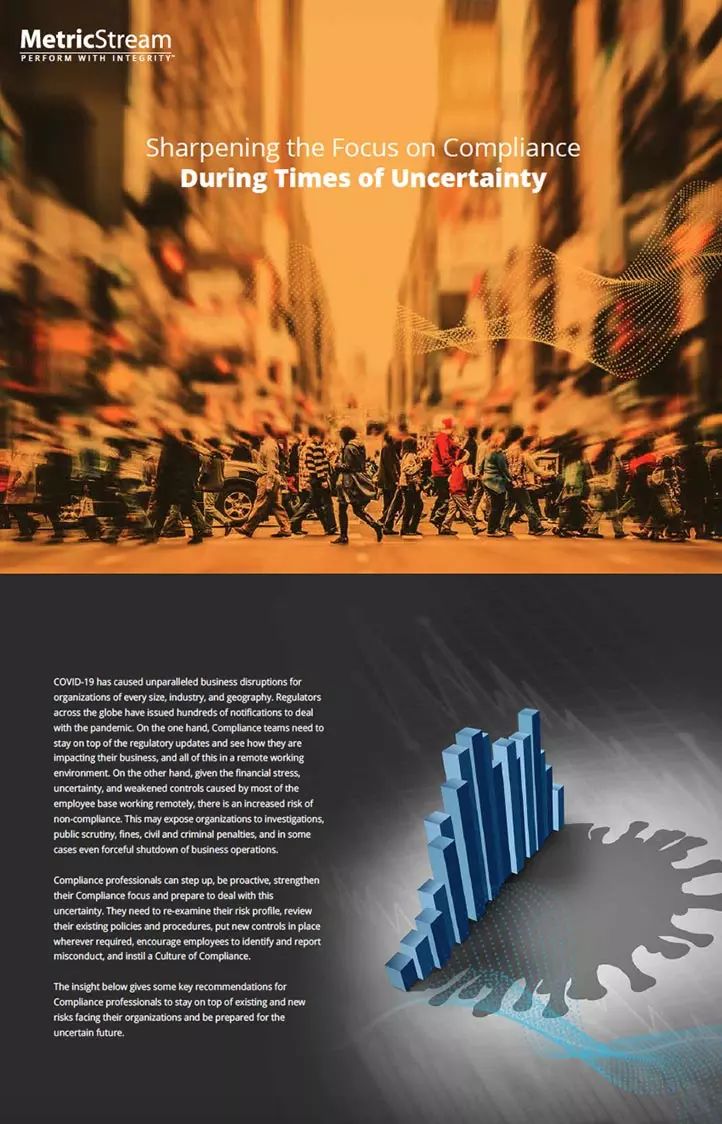
AI-First Connected GRC
Drive a Connected GRC Program for Improved Agility, Performance, and Resilience
Discover Connected GRC Solutions for Enterprise and Operational Resilience
Explore What Makes MetricStream the Right Choice for Our Customers
Discover How Our Collaborative Partnerships Drive Innovation and Success
- Want to become a Partner?
Your Insight Hub for Simpler, Smarter, Connected GRC
Sharpening the Focus on Compliance During Times of Uncertainty
COVID-19 has caused unparalleled business disruptions for organizations of every size, industry, and geography. Regulators across the globe have issued hundreds of notifications to deal with the pandemic. On the one hand, compliance teams need to stay on top of the regulatory updates and see how they are impacting their business, and all of this in a remote working environment. On the other hand, given the financial stress, uncertainty, and weakened controls caused by most of the employee base working remotely, there is an increased risk of non-compliance. This may expose organizations to investigations, public scrutiny, fines, civil and criminal penalties, and in some cases even forceful shutdown of business operations.

Compliance professionals can step up, be proactive, strengthen their compliance focus and prepare to deal with this uncertainty. They need to re-examine their risk profile, review their existing policies and procedures, put new controls in place wherever required, encourage employees to identify and report misconduct, and instill a culture of compliance.
The insight below gives some key recommendations for compliance professionals to stay on top of existing and new risks facing their organizations and be prepared for the uncertain future.
Formulate a Solid Compliance Strategy
Compliance functions while focusing on the immediate risks should also consider the risks on the horizon. They can work on a strategy that captures all aspects of the compliance program including identifying and mitigating risk, tracking and managing new regulatory obligations that impact the business, improving policies and procedures that are in place to address new risks, effectively handling compliance and ethics cases and also handling the engagement with regulators. Some of the questions they can address in the strategy are:
- What are the revised compliance obligations that we should be aware of?
- What are the new risks that we are exposed to, given the business dynamics?
- Which are the policies that we should amend and how do we effectively communicate the change?
- How do we reinforce the message of good governance and ethical practices in these challenging times and refocus on the culture of compliance?
Communicate Regularly
The focus on communication has never been more important than in today’s pandemic environment. Effective and timely communication to employees, customers, partners, and even third parties should be a key priority for organizations. Ideally, the communication should come from senior management or C-level executives to emphasize that attention is being paid to compliance and how important it is for the organization to sustain compliance.
With the remote working setup, health and safety policies, information security policies etc., need to be revised regularly. The updated policies and the risk of non-compliance need to be clearly communicated to the relevant individuals, and attestations need to be tracked. Policy awareness campaigns can be managed with awareness drives. Messaging on the company’s continued commitment to a culture of ethics and compliance, and zero tolerance for any misconduct needs to be reinforced and employees need to be encouraged to speak up. The focus should be on concentrating on the most important messages and keeping them short, engaging and empathetic.
Re-evaluate and Refocus on Risk
As the risk landscape continues to evolve, it makes sense to view compliance through a different lens. Prioritize the compliance risk areas and focus on the ones that need more attention. Focus on the risks that have spiked in the recent past. It is critical to conduct regular, dynamic risk assessments in order to quickly comprehend the new circumstances and address the risks in a holistic manner. These risks must be contained with quick and timely action plans whether it is revising policies, implementing new controls, or escalating issues. Clear and defined review and escalation mechanisms are also very important.
Leverage Technology
There are many ways technology can come to the rescue to mitigate the risks of non-compliance during uncertainty. With technology, compliance professionals, can stay on top of regulatory updates so that no important revisions are missed. They can easily update polices and procedures and get the revised policies quickly to where employees are. Policies can be easily linked to regulations, risks, processes and controls to quickly get a view into policies that are impacted. Details of compliance cases can be captured and analyzed to gather trends and the necessary controls can be implemented quickly. Technology can also help in managing comprehensive compliance assessments and facilitating quick and proactive response to any compliance issues identified. Another important benefit of technology is that organizations can ensure that all the compliance information is available in one common centralized repository. As a result, everybody involved will have access to the right information at the right time and there is no redundancy. Moreover, compliance teams can quickly see the overall compliance posture by business unit, by process, or by geography.
In conclusion, there is clearly no doubt that the current pandemic situation has disrupted businesses resulting in unparalleled economic uncertainty. Business leaders, including governance, risk and compliance (GRC) professionals are finding it difficult to navigate the storm. The focus on GRC is now more so than ever before. The compliance function should take this in its stride, viewing the current situation as an opportunity and not a threat. The more proactively compliance professionals can anticipate and mitigate risks by sharpening their focus on compliance, supported by technology, the more their business will grow, and they will be more prepared to safely navigate and stay resilient through these uncertain times.

Subscribe for Latest Updates
Subscribe Now





